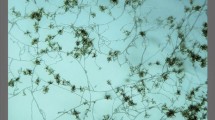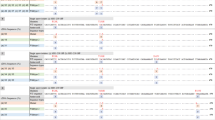Abstract
Cereal eyespot fungi Tapesia acuformis and Tapesia yallundae are closely related species which show different behaviours upon treatment with sterol 14α-demethylase inhibitors (DMIs). T. acuformis is naturally resistant to DMIs belonging to the triazole family and susceptible to the imidazole ones, whilst T. yallundae is sensitive to both inhibitors. Cloning of the target enzyme gene, CYP51, from the two species revealed an important polymorphism between them. Further sequencing of CYP51 from sixteen T. acuformis and eleven T. yallundae strains with different phenotypes with regards to resistance to DMIs confirmed that at least eleven variations are species related. Among them, a conserved phenylalanine residue at position 180, found both in T. yallundae and in all known CYP51 proteins from filamentous fungi and yeast, was replaced in T. acuformis by a leucine. Therefore, a leucine at 180 could be possibly involved in natural resistance of T. acuformis to triazoles. Other mutations were observed in some resistant strains, sometimes simultaneously, but in contrast to what was reported for other filamentous fungi, where a mutation at the 136 position of the CYP51 gene product seemed to correlate with resistance to DMIs, we did not find a clear relationship between a given mutation and a particular phenotype. This result suggests that resistance to DMIs could have a polygenic nature in Tapesia. We took advantage of species-related variations to develop a PCR-based assay allowing rapid and easy discrimination between field strains of the two species.
Similar content being viewed by others
References
Albertini C, Gredt M and Leroux P (1999) Mutations of the β-tubulin gene associated with different phenotypes of benzimidazole resistance in the cereal eyespot fungi Tapesia yallundae and Tapesia acuformis. Pesticide Biochemistry and Physiology 64: 17-31
Albertini C, Thébaud G, Fournier E and Leroux P (2002) Eburicol 14α-demethylase gene (CYP51) polymorphism and speciation in Botrytis cinerea. Mycological Research, in press
Aoyama Y, Noshiro M, Gotoh O, Imaoka S, Funae Y, Kurosawa N, Horiuchi T and Yoshida Y (1996) Sterol 14α-demethylase P450 (P45014DM) is one of the most ancient and conserved P450 species. Journal of Biochemistry 119: 926-933
Délye C, Laigret F and Corio-Costet MF (1997a) Cloning and sequence analysis of the eburicol 14α-demethylase gene of the obligate biotrophic grape powdery mildew fungus. Gene 195: 29-33
Délye C, Laigret F and Corio-Costet MF (1997b) A mutation in the 14α-demethylase gene of Uncinula necator that correlates with resistance to a sterol biosynthesis inhibitor. Applied and Environmental Microbiology 63: 2966-2970
Délye C, Bousset L and Corio-Costet MF (1998) PCRcloning and detection of point mutations in the eburicol 14α-demethylase (CYP51) gene from Erysiphe graminis f.sp. hordei a «recalcitrant » fungus. Current Genetics 34: 399-403
Délye C, RonchiV, Laigret L and Corio-Costet MF (1999) Nested allele-specific primers distinguish genetic groups of Uncinula necator. Applied and Environmental Microbiology 65: 3950-3954
Dyer PS, Nicholson P, Lucas JA and Peberdy JF (1996) Tapesia acuformis as a causal agent of eyespot disease of cereals and evidence for heterothallic mating system using molecular markers. Mycological Research 100: 1219-1226
Gac ML, Montford F, Cavelier N and Sailland A (1996) Comparative study of morphological, cultural and molecular markers for the characterization of Pseudocercosporella herpotrichoides isolates. European Journal of Plant Pathology 102: 325-337
Georgopapadakou NH (1998) Antifungals: mechanism of action and resistance, established and novel drugs. Current Opinion in Microbiology 1: 547-557
Hamamoto H, Hasegawa K, Nakaune R, Jin Lee Y, Makizumi Y, Akutsu K and Hibi T (2000) Tandem repeat of a transcriptionnal enhancer upstream of the sterol 14 α-demethylase gene (CYP51) in Penicillium digitatum. Applied and Environmental Microbiology 66: 3421-3426
Lepesheva GI, Podust LM, Bellamine A and Waterman M (2001) Folding requirements are different between sterol 14α-demethylase (CYP51) from Mycobacterium tuberculosis and human or fungal orthologs. The Journal of Biological Chemistry 276: 28413-28420
Leroux P and Gredt M (1988) Caractérisation des souches de Pseudocercosporella herpotrichoides, agent du piétin-verse des cérales, résistantes à des substances antimitotiques et à des inhibiteurs de la biosynthése des stérols. Agronomie 8: 719-729
Leroux P and Gredt M (1997) Evolution of fungicide resistance in the cereal eyespot fungi Tapesia yallundae and Tapesia acuformis in France. Pesticide Science 51: 321-327
Leroux P, Gredt M and Boeda P (1988) Resistance to inhibitors of sterol biosynthesis in field isolates or laboratory strains of the eyespot pathogen Pseudocercosporella herpotrichoides. Pesticide Science 23: 119-129
Löeffler J, Kelly SL, Hebart H, Schumacher U, Lass-Flörl C and Einsele H (1997) Molecular analysis of CYP51 from fluconazole-resistant Candida albicans strains. FEMS Microbiology Letters 151: 263-268
Marichal P, Koymans L, Willemsens S, Bellens D, Verhasselt P, Luyten W, Borgers M, Ramaekers FCS, Odds FC and Vanden Bossche H (1999) Contribution of mutations in the cytochrome P450 14α-demethylase (erg11p, Cyp51p) to azole resistance in Candida albicans. Microbiology 145: 2701-2713
Nelson DR, Kamataki T, Waxman DJ, Guengerich FP, Estabrook RW, Feyereisen R, Gonzales FJ, Coon MJ, Gunsalus IC, Gotoh O, Okuda K and Nebert DW (1993) The P450 superfamily: update on new sequences, gene mapping, accession numbers, early trivial names of enzymes and nomenclature. DNA and Cell Biology 12: 1-51
van Nistelrooy JGM, van Den Brink JM, van Kan JAL, van Gorcom RFM and de Waard MA (1996) Isolation and molecular characterization of the gene encoding eburicol 14 α-demethylase (CYP51) from Penicillium italicum. Molecular and General Genetics 250: 725-733
Podust LM, Poulos TL and Waterman MR (2001) Crystal structure of cytochrome P450 14α-sterol demethylase (CYP51) from Mycobacterium tuberculosis in complex with azole inhibitors. Proceedings of the National Academy of Science U.S.A. 98: 3068-3073
Poupard P, Simonet P, Cavelier N and Bardin R (1993) Molecular characterization of Pseudocercosporella herpotrichoides isolates by amplification of ribosomal DNA internal transcribed spacers. Plant Pathology 42: 873-881
Robbertse B, Campbell GF and Crous PW (1995) Revision of Pseudocercosporella like species causing eyespot disease of wheat. South African Journal of Botany 61: 43-48
Sanglard D, Isher F, Koymans L and Bille J (1998) Amino-acid substitutions in the cytochrome lanosterol 14α-demethylase (CYP51A1) from azole-resistant Candida albicans clinical isolates contribute to resistance to antifungal agents. Antimicrobial Agents and Chemotherapy 42: 241-253
Schnabel G and Jones AL (2001) The 14α-demethylase gene is overexpressed in Venturia inaequalis strains resistant to myclobutanil. Phytopathology 91: 102-110
Sommer R and Tautz D (1989) Minimal homology requirements for PCR primers. Nucleic Acids Research 17: 6749
de Waard MA (1996) Molecular genetics of resistance in fungi to azole fungicides. In: Brown TM (ed) Molecular genetics and evolution of pesticide resistance. ACS symposium series 645 (pp 62-71) American Chemical Society, Washington, District of Columbia
Wood HM, Dickinson MJ, Lucas JA and Dyer PS (2001) Cloning of the CYP51 gene from the eyespot pathogen Tapesia yallundae indicates that resistance to the DMI fungicide prochloraz is not related to sequence changes in the gene encoding the target site enzyme. FEMS Microbiology Letters 196: 183-187
Yoshida Y (1993) Lanosterol 14 α-demethylase (cytochrome P45014DM). In: Schenkman H and Grein K (eds) Cytochrome P450 (pp 627-639) Springer Verlag, Berlin
Author information
Authors and Affiliations
Rights and permissions
About this article
Cite this article
Albertini, C., Gredt, M. & Leroux, P. Polymorphism of 14α-demethylase Gene (CYP51) in the Cereal Eyespot Fungi Tapesia acuformis and Tapesia yallundae . European Journal of Plant Pathology 109, 117–128 (2003). https://doi.org/10.1023/A:1022584822191
Issue Date:
DOI: https://doi.org/10.1023/A:1022584822191




